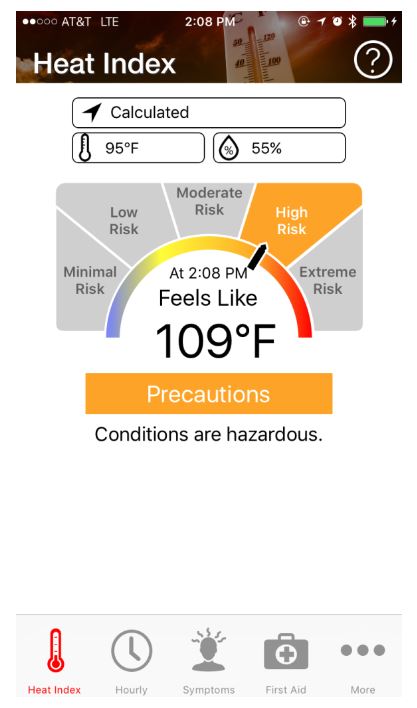Heat Index
The heat index, also known as the apparent temperature, is what the temperature feels like to the human body when relative humidity is combined with the air temperature. This has important considerations for the human body’s comfort. When the body gets too hot, it begins to perspire or sweat to cool itself off. If the perspiration is not able to evaporate, the body cannot regulate its temperature. The human body feels warmer in humid conditions. There is direct relationship between the air temperature and relative humidity and the heat index, meaning as the air temperature and relative humidity increase (decrease), the heat index increases (decreases).
(Source: National Weather Service)
Heat Safety Tool
Obtain the heat index at any time by utilizing the Heat Safety Tool App from the Occupational Safety and Health Administration (OSHA).
The app allows anyone to calculate the heat index for their current location. When the heat index is high, the app displays a risk level to those spending long amounts of time outside. Reminders can be set about the protective measures that should be taken at that risk level, such as drinking enough fluids, scheduling rest breaks, planning for and knowing what to do in an emergency and adjusting work operations.

| National Weather Service Classification | Heat Index Range (◦F) | Effect on the body | Precautions |
|---|---|---|---|
| Caution | 80 – 90 | Fatigue possible with prolonged exposure and/or physical activity | Establish, implement and maintain procedures to prevent heat illness. Water must be provided, be accessible and sufficient. Rest periods should be provided. |
| Extreme Caution | 91 – 103 | Heat stroke, heat cramps or heat exhaustion possible with prolonged exposure and/or physical activity | Encourage workers to drink one cup of water every 20 minutes under such conditions. Rest periods, not less than 15 minutes every hour, should be given. Rest areas should be shaded outdoors and cooled indoors. |
| Danger | 104 – 124 | Heat cramps or heat exhaustion likely, and heat stroke possible with prolonged exposure and/or physical activity | Work should be scheduled before 10 a.m. and/or after 4 p.m. |
| Extreme Danger | 125 or higher | Heat stroke highly likely | Stop work |


